February 11, 2012 at 8:49 pm
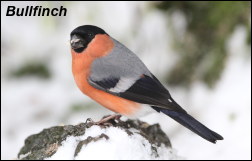
Last weekend’s snow brought a new bird to the garden in the form of a Pied Wagtail and produced a record seven Bullfinches together (four males,three females) In addition the first Siskin of the Winter appeared and there were fourteen Blackbirds feeding together on one occasion. The Willow Tit is now a daily visitor.
I travelled the two hundred and forty miles to Stranraer on Tuesday to commence my four day lecture tour of the Scottish Ornithologist Club. As last year I counted the Raptors on this journey with the Buzzard continuing to increase at nineteen sightings compared to the Kestrels two and Kites one. Last year it was fourteen Buzzards, three Kestrels and two Sparrowhawks.
Loch Ryan at Stranraer was brilliant for Scaup and Pintail and I spent a good two hours at high water filming them close in shore with plenty of Turnstones even closer to hand. At Mossdale a pair of Crossbills were present, with the female collecting nesting material and being escorted back to the forest by the male to build her nest. The young forest at Laurieston produced four Blackcocks that flew over the car. These being the first I have seen on tour for many years. A good afternoon was spent filming the Kites that had now built up to more than eighty following another good breeding season.
In a wild part of moorland forestry I was able to admire my first Great Grey Shirke for years. Better still were eight Crossbills that were bathing and drinking in a roadside pothole that had the ice broken by passing forestry venicles. I sat for an hour under the camouflage cloth awaiting their return but falling snow forced an abandonment in case I became stranded in the back of beyond without the luxury of a four wheeled drive vehicle. Another one that got away!
February 5, 2012 at 7:37 am
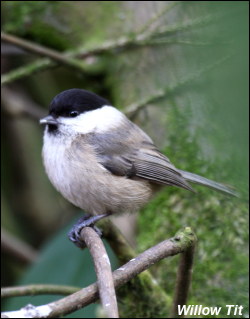
Just when we had given up all hope of seeing the Willow Tit this Winter it turned up on the twenty ninth of January for the fifth consecutive Winter. Perfect timing as it was the RSPB Garden Count day and it knocked our total up to twenty one different species in the hour slot. Not bad for a garden less that thirty foot by fifteen foot.
At long last we have had a week of superb Winter weather. I have visited Leighton Moss on several occasions and finally found a feeding Bittern. Unfortunately it was four hundred yards away and out of reach of the camera. I did however obtain film of a Marsh Harrier hunting the reed beds and even saw an Otter on the same day.
On Hopwood Jack Snipe and Woodcock have been present despite the low temperatures. The Dipper is still on the stream and a Green Woodpecker was encountered looking for ants in some frozen mosses.
In the snow of the fourth we had our best species count of the Winter with 22 recorded. These included Willow Tit, Goldcrest, Reed Bunting, Sparrowhawk and Great Spotted Woodpecker
January 29, 2012 at 1:41 pm
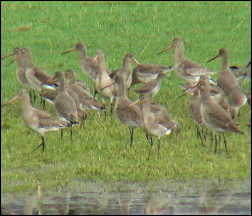
Whilst at Leighton Moss during the week I took the opportunity to watch a Glossy Ibis that was feeding in the corner of a field. I have never seen one before and whilst it was interesting to see I would have preferred a Bittern any day. At high tide Black Tailed Godwits left the shore to feed in a flooded field by the reserve. They were feeding at a rapid rate and as soon as the tide turned they flew back to the shore line. As for Bitterns, there were none visible once again!
Along the canal during the week were a pair of Goosanders, a Grey Wagtail and up to eight Pied Wagtails . A Fox was also present. On Hopwood was a Dipper, feeding along Trub Brook, the first I have seen there for more than a year.
The garden has been very active this week with three days when twenty one species of birds were feeding. Included in those were eight Long Tailed Tits, two Reed Buntings, four Bullfinches, Wren and the first Goldcrest for more than a year.
January 22, 2012 at 8:05 pm
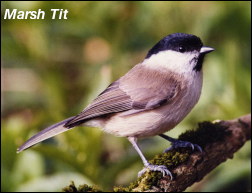
The crisp weather of last weekend extended to Monday so I decided to go to Leighton Moss to seek the Bitterns that had been showing very well over the weekend. Unfortunately minus five degrees centigrade overnight completely froze the reserve water and there wasn’t a Bittern in sight. I did , however, watch the Marsh Tits on the bird feeders and remembered how I used to encounter these birds in the Ribble and Hodder valleys. It is sad that I have not seen one in those localities for more than two years and so quick is the decline of this bird that it has now been added to the Red List making it one of Britain’s most threatened species. At present there are no apparent reasons why they are decreasing so quickly, so all the people who go to Leighton Moss to look for Bitterns should spare some time to admire the Marsh Tit before it is too late.
It always amazes me as to how everyone’s individual gardens attract different species and numbers of birds. A friend from Huddersfield phoned during the week and invited me to come and have look at his garden. What was so special about his garden? He just happened to have more than fifty Redpolls feeding on three large niger seed feeders hung outside his conservatory. There was no light to film but just to witness this spectacle was amazing. Why were they attracted to his garden? Well it was on the edge of a mature undisturbed wood, an enormous amount of niger seed was put out for them and there were no cats or Grey Squirrels. All other reasons are known only to the Redpolls themselves!
January 15, 2012 at 9:29 pm
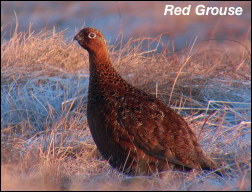
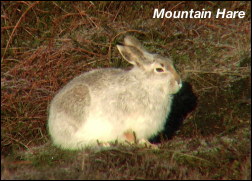
Two superb frosty and sunny days with very little wind. Just the conditions I had been waiting for to venture onto the top of the Pennines in search of Red Grouse and Mountain Hares. Saturday was the best of the two with good numbers of hares resting in their forms in the pleasant sunshine. As usual they do not allow too close an approach but with careful stalking they may be approached to about thirty foot. One allowed a much closer view but unfortunately it was in such deep cover that only its eye could be seen in heavy white frost.
As I was about to leave the moor a white movement caught my eye and this was no Mountain Hare. It was an Ermine ( White Stoat) and only the third I have ever seen. I was certainly not expecting such a creature at an altitude of one thousand two hundred feet. Unfortunately, though I saw it on three occasions it was searching a rushy gully for food and failed to perform for the camera. I checked the same area the following day but there was no sign of it. Whilst I was on the high tops three skeins of five hundred,two hundred and one hundred Pink Footed Geese flew over in a North West direction.
At dusk, on Hopwood, both Woodcock and Jack Snipe were present in areas that remained clear of ice.
January 8, 2012 at 6:40 pm
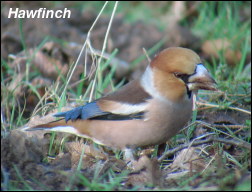
What a start to the New Year. After forty years of trying I finally obtained film of the elusive Hawfinch. On the one good day of the week I journeyed to the Northern Dales as I had done on many occasions before to try to locate Hawfinches. This time, shortly after dawn, up to five Hawfinches fed on the ground on the seeds of Hornbeams. It was a magical sight I thought I would never see and film and although they only fed for a matter of minutes it was a moment I shall remember for ever. That enormous bill and the way they can take off vertically will brighten up what has so far been an abysmal Winter.
In the garden a very large female Sparrowhawk caught a Starling and flew off with it still squawking. Three Wood Pigeons fed together on one day and a Fox walked along the rear of the garden in the middle of the afternoon on another day. Sadly a cat was seen to vacate the garden with a bird on another occasion. Grey Squirrels have now peaked at three which is, of course, three too many.








